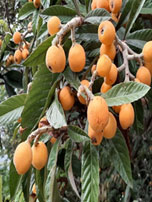SHAHEED KARTAR SINGH SARABHA AYURVEDIC MEDICAL COLLEGE & HOSPITAL
Affiliated to Guru Ravidas Ayurved University, Hoshiarpur Punjab
Affiliated to Guru Ravidas Ayurved University, Hoshiarpur Punjab

Botanical Name : Eriobotrya japonica
Family : Rosaceae
Introduction :
A fruit of wide appeal, the loquat, Eriobotrya japonica Lindl., (syn. Mespilus japonicus Thunb.), of the rose family, Rosaceae, has been called Japan, or Japanese, plum and Japanese medlar. To the Italians, it is nespola giapponese; to French-speaking people, it is néflier du Japon, or bibassier. In the German language, it is japanische mispel, or wollmispel; in Spanish, nispero, nispero japonés, or nispero del Japón; in Portuguese, ameixa amarella, or ameixa do Japao.
Morphology :
A tree of moderate size, the loquat may reach 20 to 30 ft (6-9 in), has a rounded crown, short trunk, and woolly new twigs. The evergreen leaves, mostly whorled at the branch tips, are elliptical-lanceolate to obovate lanceolate, 5 to 12 in (12.5-30 cm) long and 3 to 4 in (7.5-10 cm) wide; dark-green and glossy on the upper surface, whitish-or rusty-hairy beneath, thick, stiff, with conspicuous parallel, oblique veins, each usually terminating at the margin in a short, prickly point. Sweetly fragrant flowers, borne in rusty-hairy, terminal panicles of 30 to 100 blooms, are white, 5-petalled, 1/2 to 3/4 in (1.25-2 cm) wide. The fruits, in clusters of 4 to 30, are oval, rounded or pear-shaped, 1 to 2 in (2.5-5 cm) long, with smooth or downy, yellow to orange, sometimes red-blushed, skin, and white, yellow or orange, succulent pulp, of sweet to subacid or acid flavor. There may be 1 to 10 seeds, though, ordinarily, only 3 to 5, dark-brown or light-brown, angular -ellipsoid, about 5/8 in (1.5 cm) long and 5/16 in (8 mm) thick.
Distribution :
The loquat is indigenous to southeastern China and possibly southern Japan, though it may have been introduced into Japan in very early times. It is said to have been cultivated in Japan for over 1, 000 years. The western world first learned of it from the botanist Kaempfer in 1690. Thunberg, who saw it in Japan in 1712, provided a more elaborate description. It was planted in the National Gardens, Paris, in 1784 and plants were taken from Canton, China, to the Royal Botanical Gardens at Kew, England, in 1787. Soon, the tree was grown on the Riviera and in Malta and French North Africa (Algeria) and the Near East and fruits were appearing on local markets. In 1818, excellent fruits were being produced in hothouses in England. The tree can be grown outdoors in the warmest locations of southern England.
Cultivation spread to India and southeast Asia, the medium altitudes of the East Indies, and Australia, New Zealand and South Africa. Chinese immigrants are assumed to have carried the loquat to Hawaii.
In the New World, it is cultivated from northern South America, Central America and Mexico to California: also, since 1867, in southern Florida and northward to the Carolinas, though it does not fruit north of Jacksonville. It was quite common as a small-fruited ornamental in California gardens in the late 1870’s. The horticulturist, C.P. Taft, began seedling selection and distributed several superior types before the turn of the century, but further development was slow. Dwarfing on quince root-stocks has encouraged expansion of loquat cultivation in Israel since 1960. In the northern United States and Europe, the tree is grown in greenhouses as an ornamental, especially var. variegata with white and pale-green splashes on the leaves.
In India and many other areas, the tree has become naturalized, as it volunteers readily from seed. Japan is the leading producer of loquats, the annual crop amounting to 17,000 tons. Brazil has 150,000 loquat trees in the State of Sao Paulo.
Medicinal Uses :
The fruit is said to act as a sedative and is eaten to halt vomiting and thirst.
The flowers are regarded as having expectorant properties.
An infusion of the leaves, or the dried, powdered leaves, may be taken to relieve diarrhea and depression and to counteract intoxication from consumption of alcoholic beverages.
Leaf poultices are applied on swellings.
